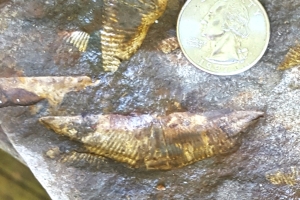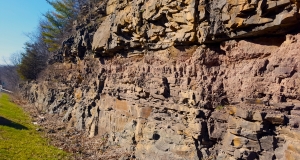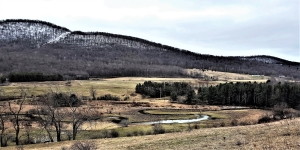Joints along Rte. 145 – Apr. 11, 2024
Joints along Rte. 145
The Catskill Geologists; The Mountain Eagle, May 16, 2019
Robert and Johanna Titus
Science may seem cut and dried to many. We scientists just know everything, don’t we? We look at things and figure them right away. Don’t we? Well – no, and no again. Sometimes we see things that we just can’t figure out. The two of us have been having that sort of a problem lately and it all began along Rte. 145, That’s at the top of the hills you see as you approach Middleburgh from the south. On the right side of the highway is an impressive outcropping of typical Catskill sandstone. Take a look at our photo.
That outcrop makes up a very fine wall of rock. It actually seems too fine. The rock exposes several nearly perfect, smooth and upright surfaces – too smooth and too upright. What is going on here? Rocks are supposed to break up into jagged rough blocks, aren’t they? It looks like we have some explaining to do.

These surfaces are fractures in the rock that are called geological joints. There is a good bit of scientific theory behind this. Joints record chapters in the tectonic history of a region. They began to form when the rocks, long ago, came to be compressed during a tectonic event. It may be hard to imagine that rocks can be squeezed, but they can. That requires immense pressures, but such pressures do occur within the Earth’s crust – deep within the crust.
Now the funny thing about all this is that rocks do not fracture when they are being compressed; they have enough “give” to absorb that stress. But compression does not last forever; it eventually does end. Rocks then expand and that is when the fracturing begins. There is a sort of relaxation which occurs as the pressure eases. At that moment we find that rocks are brittle, and it is exactly then that they crack to form joints. So, what triggered all this? We need more scientific theory.
Cycles of compression and relaxation, strong enough to deform and fracture rocks, can only be associated with the truly great tectonic events. These are not just run of the mill earthquakes; these are the towering mountain building events. And the one which triggered our Rte. 145 joints was one of the biggest mountain building events ever. That was the collision of Europe with North America, about 400 million years ago; it made the northern Appalachians. Episodes of compression and relaxation, associated with massive uplift of the crust, is what created these joints.
All this is good sound scientific theory, so what’s the problem? Take another good look at our photo. Do you see how it appears that large masses of jointed rock came to be yanked out of the ground and carried off toward we, the photographers. How on earth did that ever happen? Well, that’s our problem. We can tell you how we would like it to have happened. We stand there and imagine a glacier rising up the valley. The west moving ice passes by and forms a bond with the bedrock. Ice does that; stick your tongue to the bottom of an ice tray and you will find out for yourself. Well, as the ice continued up the valley, it did that yanking; blocks of rock were plucked out of the ground and dragged off toward Middleburgh.
At least we would like that to have happened; it would be such a nice vision of ice age history. But just can’t convince ourselves that it happened that way; road building seems very likely to have helped out, and that takes the Ice Age out of the story. So, where does that leave us? Well – with an unsolved mystery. We’ll figure it out someday -and get back to you about it.
Contact the authors at randjtitus@prodigy.net. Join their facebook page “The Catskill Geologist.”












